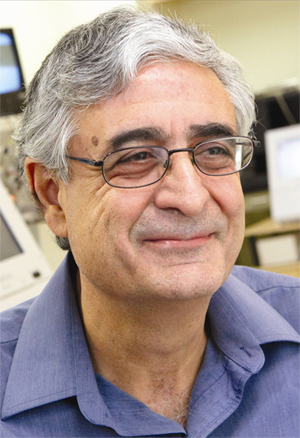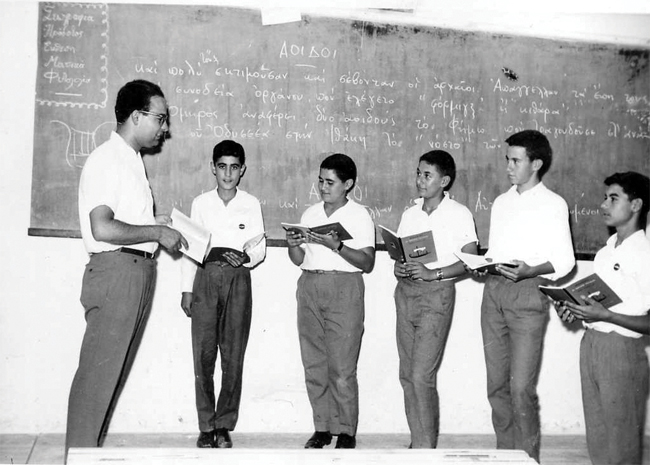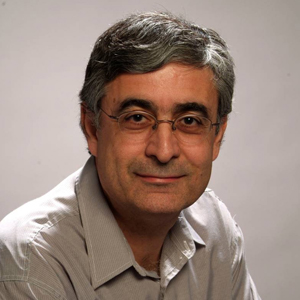From a personal disease
to a personal research project
In 1964, I was an energetic 12-year-old living in my homeland, the island of Cyprus. Every August, our village filled with workers from other parts of the island who helped collect carobs, then the most valuable agricultural product of the island. My family owned thousands of trees, and I worked alongside my parents and our hired workers at least 12 hours a day for about a month. Tough labor, but well taken by a healthy young boy.
 Eleftherios P. Diamandis researched the effects of a parasitic infection he suffered during his boyhood.Courtesy of eleftherios p. diamandis
Eleftherios P. Diamandis researched the effects of a parasitic infection he suffered during his boyhood.Courtesy of eleftherios p. diamandis
One evening, after one of those days of hard work, I woke up abruptly in the middle of the night, vomiting hard. I became very ill with a high fever and chills. My parents suspected a bad flu or food poisoning. The next day I went to the family doctor, who found nothing and also thought it was a flu. But the malaise, fever and chills did not subside, and after a week there was no diagnosis or improvement. I was desperate, and my parents thought I was going to die. I was admitted to the local hospital, where chest X-rays revealed two 10-centimeter symmetric masses, one in each lung lobe. There was calcification around them, and the specialist made the diagnosis of Echinococcus granulosus, or EG infection, with cysts in the lungs.
EG is a parasite that infects and lives in the gut of its definitive host, usually a dog or other carnivore. Intermediate hosts include farm animals, such as sheep and goats. Humans and sheep are infected through ingestion of unwashed vegetables or other products contaminated with eggs of the parasite from dogs’ stool or through direct contact. After infection, the parasites form cysts containing larvae, usually in the liver and lungs of humans. Patients may be asymptomatic for years but get sick when a cyst ruptures or mechanically interferes with the organs. This disease was endemic in Cyprus in the 1960s and ’70s, largely because household sheep were sacrificed in unauthorised places and their EG-infected organs, such as lungs and livers, were thrown to stray dogs, which were then infected. This is the EG cycle: from sheep to dogs to humans. Cyprus eradicated the disease in the 1980s by eliminating stray dogs and mandating animals be sacrificed only in government-controlled slaughterhouses.
Instead of going back to school that September, I had an operation to remove one of the cysts, which had partially ruptured and caused the anaphylactic reaction. The surgery included removal of some ribs and part of the lung. The same operation was repeated on the other lung a year later. These big operations hampered my physical development and my athletic performance. People at the beach were curious about big scars on my chest, but I did not look back. The EG chapter seemed closed.
I went to the University of Illinois at Urbana-Champaign in 1981 for a brief postdoc training. The compulsory medical screen included chest and abdominal X-rays. I was a bit worried when the university medical officer asked to discuss my results. They had found a big, calcified mass in the liver and thought it was a tumor. I reassured them it was another Echinococcus cyst that I knew about. My doctors suggested it should not be removed since the larvae, after all these years, were likely dead. As they put it, it was a garbage basket in my liver that was better left alone.
I did not think much about my disease for 40 years, but about five years ago, the emergence of immunotherapy for cancer gave me the idea of examining the possible relationship between EG infection and cancer. Based on existing literature, the expectation was that a chronic infection could protect against cancer due to the intensified immune surveillance. In published examples, some parasitic and other infectious diseases confer protection against cancer development. Also, a Turkish group had hinted that patients who have surgery for EG are never found to have concomitant cancer.
 The author, second from left, looking at the camera, grew up on the island of Cyprus, where at age 12 he contracted a parasitic infection that caused large cysts to develop in his lungs and liver. Cyprus eradicated the disease in the 1980s. Courtesy of eleftherios p. diamandis
The author, second from left, looking at the camera, grew up on the island of Cyprus, where at age 12 he contracted a parasitic infection that caused large cysts to develop in his lungs and liver. Cyprus eradicated the disease in the 1980s. Courtesy of eleftherios p. diamandis
I chose to do this research for the following reasons:
I was curious whether my old infection was increasing or decreasing my cancer risk. This information could be useful to others and lead to some practical benefits, such as vaccination against EG antigens to reduce cancer risk.
It was a good time to do the study; 40 years had elapsed since my infection (enough for cancer development) and, as mentioned, the infection became extinct in Cyprus after 1980.
I found a retired collaborator in Cyprus who worked with the Ministry of Health in the 1960s and had records on who developed EG infection between 1960 and 1980, along with their contact info. At that time, there were no electronic records or e-mails, Tweeter or Facebook, or even personal phones.
My plan included placing a postdoc in Cyprus who was responsible for the whole project. The postdoc recruited 6 to 8 volunteers to help with the interviews. Each patient had to be located and interviewed at his or her home to verify the EG infection and the patient’s current state of health, including diagnosis of cancer. At the same time, we recruited control subjects (age and gender-matched siblings or neighbors) for comparison. Many of the patients were dead, and we had to interview their relatives. I won’t detail all the difficulties we encountered, but some lessons are listed below. All in all, this study was a logistical and financial nightmare.
After three years of hard work, we ended up recruiting 249 patients and 753 controls (we hoped for a lot more but could not find them). Our study was underpowered, especially when we broke down the cancers according to organs affected. Our results were equivocal, and we ended up publishing them in a small journal as preliminary evidence. The reviewers killed us with criticisms, mostly justified. Our overall finding was an approximate 25 percent increase in cancer risk in EG-infected patients.
This exercise taught me some tough (but obvious to the specialist) lessons:
- Sentimentally motivated projects based on subjective criteria may cost a lot and carry increased risks of failure.
- Epidemiological studies linking diseases with candidate causative factors need to be planned carefully and powered appropriately. Better not to do an underpowered study than to start a study and then realize that recruitment is much smaller than expected.
- There may be a myriad of hidden biases with such studies, which could lead to wrong conclusions.
In the end, I learned that I should stick to what I do best and leave the epidemiological studies to the experts. Our results showed the exact opposite of my original hypothesis. My dream of finding a condition (such as EG infection) that prevents cancer development was shattered, and my anxiety about developing cancer in the future not only did not decrease but increased by about 25 percent.
I paid dearly for my sentimentally motivated mistake.
Enjoy reading ASBMB Today?
Become a member to receive the print edition four times a year and the digital edition monthly.
Learn moreGet the latest from ASBMB Today
Enter your email address, and we’ll send you a weekly email with recent articles, interviews and more.
Latest in Opinions
Opinions highlights or most popular articles

Sketching, scribbling and scicomm
Graduate student Ari Paiz describes how her love of science and art blend to make her an effective science communicator.

Embrace your neurodivergence and flourish in college
This guide offers practical advice on setting yourself up for success — learn how to leverage campus resources, work with professors and embrace your strengths.

Survival tools for a neurodivergent brain in academia
Working in academia is hard, and being neurodivergent makes it harder. Here are a few tools that may help, from a Ph.D. student with ADHD.

Hidden strengths of an autistic scientist
Navigating the world of scientific research as an autistic scientist comes with unique challenges —microaggressions, communication hurdles and the constant pressure to conform to social norms, postbaccalaureate student Taylor Stolberg writes.

Black excellence in biotech: Shaping the future of an industry
This Black History Month, we highlight the impact of DEI initiatives, trailblazing scientists and industry leaders working to create a more inclusive and scientific community. Discover how you can be part of the movement.

Attend ASBMB’s career and education fair
Attending the ASBMB career and education fair is a great way to explore new opportunities, make valuable connections and gain insights into potential career paths.

